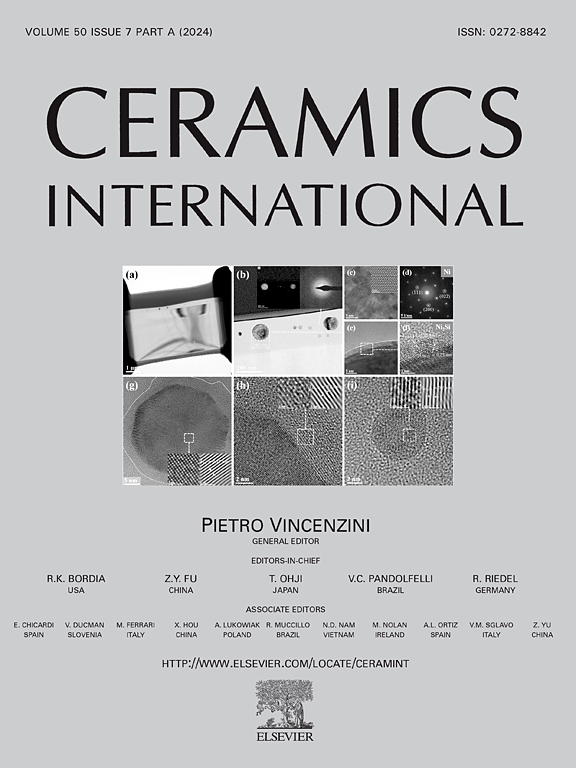Improving energy storage performance of (Bi0.5Na0.5)0.94Ba0.06TiO3-based high-entropy ceramics by A/B-site Co-regulation
IF 5.6
2区 材料科学
Q1 MATERIALS SCIENCE, CERAMICS
引用次数: 0
Abstract
Due to the novel high-entropy effects, entropy engineering strategies have been widely implemented in perovskite dielectric ceramics to improve their comprehensive energy storage performance. In this study, by designing (Bi0.5Na0.5)0.94Ba0.06)0.75(Ca0.5Sr0.5)0.25TiO3 matrix and co-doping of Nd3+ at A-site and (Zr1/3Hf1/3Sn1/3)4+ at B-site, novel (Bi0.5Na0.5)0.94Ba0.06TiO3-based high-entropy ceramics (HECs) are developed to optimize energy storage performance. The results reveal that the configuration entropy can be improved by co-regulation of A/B-site compositions, and the increased entropy can promote the suppression of grain size, the enhancement of dielectric relaxation and impedance, and the widening of band gap, giving rise to small remanent polarization and great breakdown strength (Eb). Eventually, the composition with the maximum entropy of 1.92R exhibits superior recoverable energy storage density (Wrec ∼ 6.84 J/cm3) and high efficiency (η ∼ 82.9 %) at a large Eb ∼ 597 kV/cm, as well as good temperature stability, frequency stability and charge-discharge characteristics. These findings imply that designing high-entropy systems through A/B-site co-regulation is an effective approach for developing high-performance energy storage devices.
A/ b位共调控提高(Bi0.5Na0.5)0.94 ba0.06 tio3基高熵陶瓷储能性能
由于新型的高熵效应,熵工程策略被广泛应用于钙钛矿介质陶瓷中,以提高其综合储能性能。本研究通过设计(Bi0.5Na0.5)0.94Ba0.06)0.75(Ca0.5Sr0.5)0.25TiO3基体,并在a位共掺杂Nd3+,在b位共掺杂(zt1 / 3hf1 / 3sn1 /3)4+,制备了新型(Bi0.5Na0.5)0.94Ba0.06 tio3基高熵陶瓷(HECs),以优化储能性能。结果表明,A/ b位组成的共同调节可以提高结构熵,增加的熵可以抑制晶粒尺寸,增强介电弛豫和阻抗,扩大带隙,从而产生小的剩余极化和大的击穿强度(Eb)。最终,最大熵为1.92R的组合物在Eb ~ 597 kV/cm下具有优异的可回收储能密度(Wrec ~ 6.84 J/cm3)和高效率(η ~ 82.9%),并具有良好的温度稳定性、频率稳定性和充放电特性。这些发现表明,通过A/ b位点协同调控设计高熵系统是开发高性能储能装置的有效途径。
本文章由计算机程序翻译,如有差异,请以英文原文为准。
求助全文
约1分钟内获得全文
求助全文
来源期刊

Ceramics International
工程技术-材料科学:硅酸盐
CiteScore
9.40
自引率
15.40%
发文量
4558
审稿时长
25 days
期刊介绍:
Ceramics International covers the science of advanced ceramic materials. The journal encourages contributions that demonstrate how an understanding of the basic chemical and physical phenomena may direct materials design and stimulate ideas for new or improved processing techniques, in order to obtain materials with desired structural features and properties.
Ceramics International covers oxide and non-oxide ceramics, functional glasses, glass ceramics, amorphous inorganic non-metallic materials (and their combinations with metal and organic materials), in the form of particulates, dense or porous bodies, thin/thick films and laminated, graded and composite structures. Process related topics such as ceramic-ceramic joints or joining ceramics with dissimilar materials, as well as surface finishing and conditioning are also covered. Besides traditional processing techniques, manufacturing routes of interest include innovative procedures benefiting from externally applied stresses, electromagnetic fields and energetic beams, as well as top-down and self-assembly nanotechnology approaches. In addition, the journal welcomes submissions on bio-inspired and bio-enabled materials designs, experimentally validated multi scale modelling and simulation for materials design, and the use of the most advanced chemical and physical characterization techniques of structure, properties and behaviour.
Technologically relevant low-dimensional systems are a particular focus of Ceramics International. These include 0, 1 and 2-D nanomaterials (also covering CNTs, graphene and related materials, and diamond-like carbons), their nanocomposites, as well as nano-hybrids and hierarchical multifunctional nanostructures that might integrate molecular, biological and electronic components.
 求助内容:
求助内容: 应助结果提醒方式:
应助结果提醒方式:


